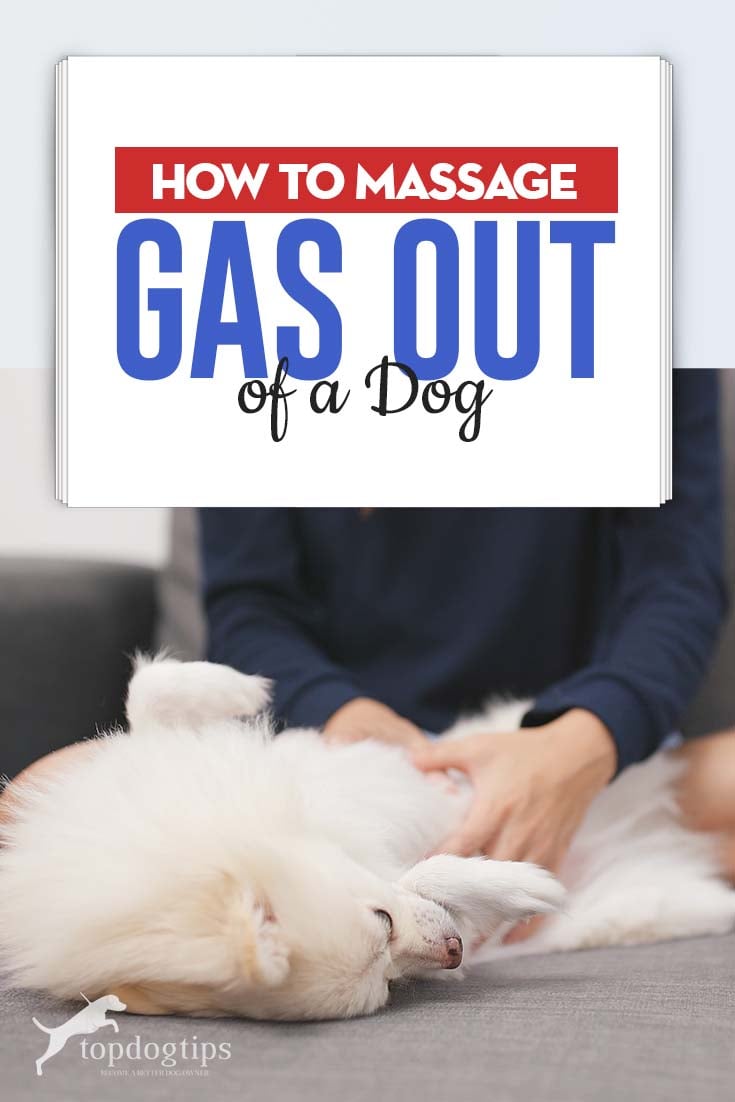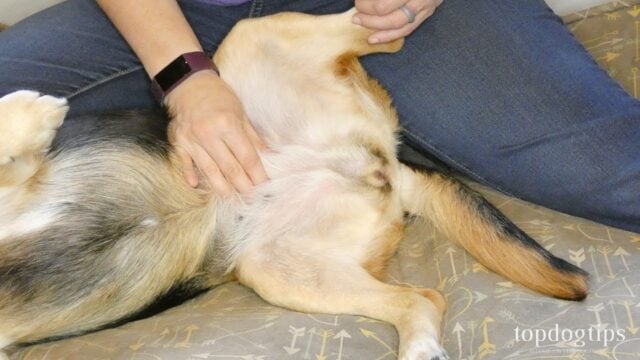
Table of Contents
- How to Massage Gas Out of a Dog in 3 Simple Steps
- Why Gas Build-up Happens in Dogs
- How Massage Works to Relieve Dogs
- Signs of Dog Gassy Stomach
- How to Prevent Gas in Dogs
- More Things to Remember When Massaging Gas Out of a Dog
- How to Massage Gas Out of a Dog: FAQs
- How to Massage Gas Out of a Dog: Before You Go…
I‘m sure, at some point, you have experienced this yourself—excessive gas, so uncomfortable, you can't even sit still.
But if you think we humans have it bad, our dogs get it way worse.
Normally, gas in dogs is common and harmless.
But if it happens too often, and you see visible signs of discomfort in your dog, I suggest you visit your vet.
While it's unlikely, there are times that this might be a sign of an underlying health issue.
According to VCA Hospitals,
Most cases of chronic flatulence are caused by a diet that the dog poorly digests.
These poorly digestible diets cause excessive fermentation in the colon and subsequent gas formation.
While medical therapy and a change in diet might be necessary to treat chronic flatulence in dogs, you can help your furry friend relieve the discomfort on your own.
Sometimes, a good ol' relaxing massage can do the trick!
Here are three simple ways how to massage gas out of a dog.
How to Massage Gas Out of a Dog in 3 Simple Steps
Unfortunately, some dogs cannot pass gas on their own. They suffer from gas build-ups in their systems, which is extremely uncomfortable.
Massaging parts of your dog's tummy will relieve him of this gas and alleviate his discomfort.
However, giving a massage does not and should not replace your vet's advice.
There is a certain way that dogs should be handled, and just massaging freely will not benefit them the way you want.
And before we discuss the ways to massage gas out of your dog, I have one reminder for you.
Be gentle and only apply pressure when necessary.
Your dog's built-up gas may be painful, and putting unnecessary pressure may unsettle him.
Here's how you can relieve your dog of this discomfort.
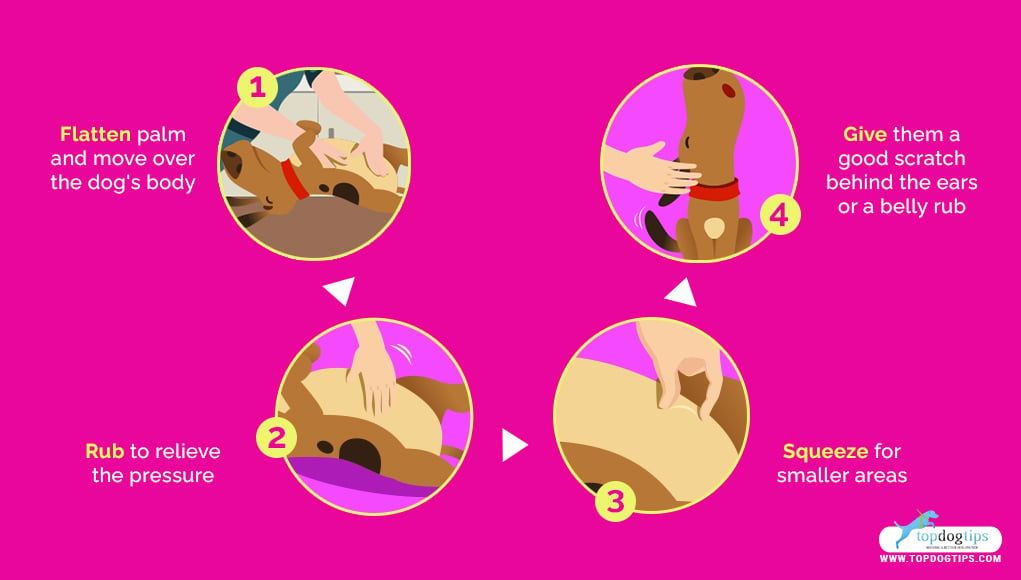
1. Identify the Hardened Areas on Your Dog's Tummy
Have your dog lie flat on his back.
What I advise is to start him with a belly rub. That way, your dog will relax and willingly show you his stomach.
Then, use your flat palm to move over your dog's tummy and sides.
Don't use pressure yet! Just enough for you to feel the hard areas versus those that are soft and malleable.
The harder spot is where your dog's gas builds up.
2. Start Rubbing and Squeezing the Hard Areas
Feel your dog's layers, hair, skin, fat, muscle, and bone.
Still using your flat palm, rub his tummy and sides with just enough pressure. Do it in a downward stroke, then in a circular motion.
Do not do it too hard, or you might hurt your pup.
If you feel the hardness in smaller areas in your dog's tummy, you may try to squeeze instead.
But again, just with enough pressure that you don't hurt him.
3. Make Your Dog Feel Relaxed
Make the massage experience a pleasant one for your dog. Give him a good scratch behind the ears or more belly rubs.
Ensure that he associates the massage with a good feeling rather than leaving him feeling uncomfortable and violated.
For a visual guide, you can check out my colleague Samantha's video below on how she does this to her dog, Molly.
Don't worry if you notice that there's still tension in your dog's tummy after massaging it for a couple of minutes.
The built-up gas should work out of their body overnight or after some relaxation.
If there is still gas the next day, just repeat this process!
If you made his first massage a positive experience, he would willingly lie down on his back for some more bell rubs.
Why Gas Build-up Happens in Dogs
There are several reasons why gas build-ups happen to our furry friends, mostly because of something they ate.
The most common one is because they swallow too much air.
When dogs eat too quickly, they eat their food and inhale too much air, causing it to build up in their stomachs.
It can also happen when your dog eats immediately after an exercise or strenuous activity.
This can be fixed using slow dog feeders to slow their breathing first before attempting to eat.
You can also train your dog to eat on cue.
If you're living in a multiple-pet household, chances are, your dog is also trying to compete for the food.
Let him know there's enough food for everyone and no reason to eat fast.
Another possible reason for this gas build-up is the bacterial fermentation in the stomach.
Yes, food ferments in our stomachs. And where there's fermentation, there's gas!
This can be from eating “gas-positive” foods like soybeans, beans, peas, spoiled foods, milk, spices, and many other high-fiber foods.
Most of these are difficult for a dog to digest, allowing the gas to spill over and out of his body.
Some other potential causes of gas in dogs include poor nutrition, medical issues, anxiety, and stress.
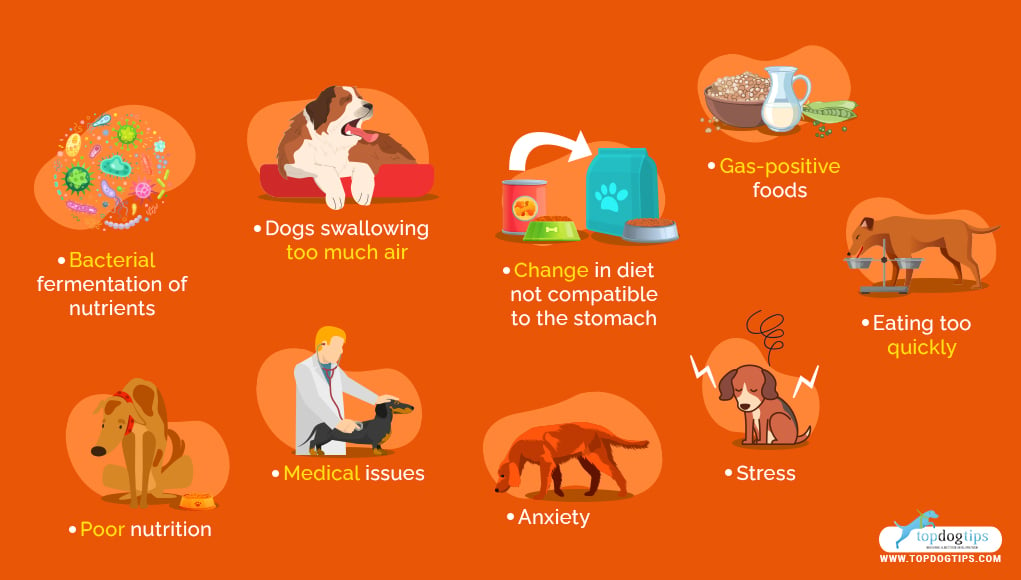
How Massage Works to Relieve Dogs
Because gas can be related to stress and anxiety, massaging your dog in areas unrelated to digestion can relieve his discomfort.
Apart from built-up gas, massaging also helps them with soreness and anxiety.
Soreness. When dogs, especially seniors, do strenuous activities that their bodies are no longer used to, they will show signs of soreness, like limping or constantly lying down.
As their bodies suffer, they may clench their bodies in pain.
The best way to relieve it is to give your dog a relaxing massage by squeezing his muscles to remove the tension from the tendons.
No sudden or direct force is needed. Massaging over the next few days will reduce their soreness and keep it away.
Anxiety. Anxiety affects a dog's mental and physical health. An anxious dog tenses up and blocks up his systems.
He's more likely to become constipated and be stuffed with gas.
Giving him a massage will help calm down his anxiety and, eventually, pass gas.
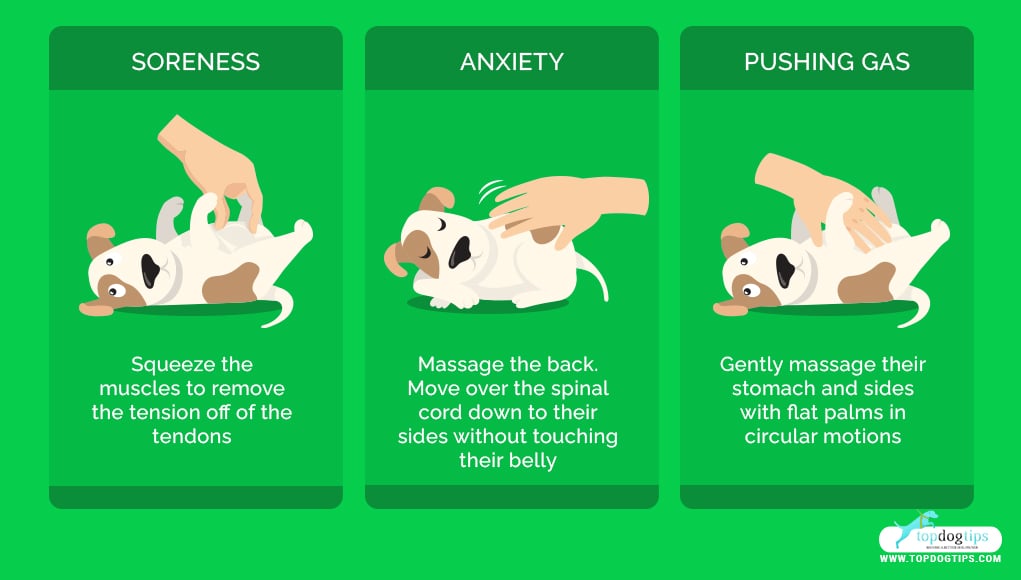
Other Areas to Massage Gas Out of a Dog
Sure, the best method to massage gas out of a dog will be to push it from his tummy.
But massaging other areas can help, too!
Head. Did you know that pressure points in the dog's head aid in gas relief?
You can start massaging near their eyes since it soothes the bladder, gall bladder, and stomach.
Rubbing their head also keeps them calm.
Ears. You can alleviate your dog's anxiety by rubbing behind his ears. It gives him comfort when he's uneasy!
Rubbing behind their ears allows them to shake their body and move their stomach muscles, aiding in dog gas relief.
Back. Patting your dog's back can make him feel calmer.
If he also tends to move a lot while massaging his stomach, you can start rubbing his back to keep him still.
Hind Legs. Massaging their hind legs helps relax their muscles in the pelvic area and soothe other regions connecting to the stomach.
It also improves digestion, tissue repair, and flexibility.
ALSO READ: Do Dogs Like Massages? Why and What You Should Know
Dog Struggling to Poop? Massage him!
This might sound gross, but we know how fart and poop go hand in hand, right?
If your pup struggles not only to pass gas but to pass his stool, massage can still help.
You can do this in more ways than one.
Here, you can:
- Express your dog's anus for on-demand pooping
- Rub his back and abdomen
Yes, the first option is exactly what you think it is.
You'd have to massage your dog's anus in a pinching motion until he poops.
Gross? I'm with you!
If that's too much, you can go ahead and do the second and more friendly option, which is massage.
You can check out this article to learn how to make your dog poop quickly.
Signs of Dog Gassy Stomach
Remember, flatulence is quite common among dogs.
There's no need to rush them to the vet whenever you see them trying to pass gas (unless it's so chronic that they're visibly in pain!)
A common sign that your dog has excessive gas is when his stomach looks bloated.
Inspect their tummy and see if it's hardened. (See Step #1 above.)
You can also listen to their stomach and determine the rumblings. You'll notice that it's like listening to the weird sound a hollow vat makes.
Also, pay attention to the smell. There's a difference between foul-smelling and odorless gas coming out.
If your dog's bloating persists for days, have your vet take a look at your dog.
Flatulence, loose stools, and vomiting may indicate an underlying health issue.
How to Prevent Gas in Dogs
Remember when I said that a dog's diet is a factor that causes them to build up gas?
This means that if you have a gassy dog, changing their diet might help.
BUT… only do so with your vet's advice.
If this is done incorrectly or prematurely, this new diet might only result in an even worse flatulence and stomach upset.
Giving your dog probiotics will also help improve his gut health.
More Things to Remember When Massaging Gas Out of a Dog
Here are a couple more things you should note when massaging gas out your dog's tummy.
- Start your massage gradually and only with the slightest pressure.
- Focus on one area at a time.
- Use a rhythmic movement when massaging your dog.
- Always check if your dog is comfortable. Give him the occasional rub on the ear or head as needed.
- If some gas has been expelled, your dog will want to move and get up. Let him, as the remaining gas will naturally work out once your dog relaxes.
- Don't let him run around or do strenuous activity until after the gas has passed.
How to Massage Gas Out of a Dog: FAQs
If you are unsure how to massage gas out of a dog or have related questions, you’ll likely find the answers here, as we’ve compiled these FAQs for your benefit.
What foods give dogs gas?
Foods like soy, peas, beans, dairy products, high-fat diets, and spicy foods are frequently linked to canine flatulence.
Additionally, the creation of vile-smelling gas is increased by foods like broccoli, cauliflower, spices, onions, and cabbage.
How do vets treat simple bloat?
Simple bloat in dogs is typically treated in a hospital with IV fluids, medications to assist the stomach empty, and regular walks to encourage bowel movements.
To prevent the stomach tissue from deteriorating and relieve pressure on the nearby organs, your vet will discharge the accumulation of gas and air inside the stomach.
How do you get rid of trapped gas in dogs?
You can get rid of trapped gas in your dog by gently massaging his stomach in circles with your palms.
What can I give my dog for trapped gas?
If your dog has trapped gas, try giving him some yogurt, ginger, or edible peppermint.
All of these methods work on both humans and dogs.
Can I give my dog anything for gas?
If your dog regularly has gas problems, your vet may suggest giving him a supplement, antacid, or another medication to help reduce the gas problems in the future.
You can also check out our guide below:
How to Massage Gas Out of a Dog: Before You Go…
Massage, when done right, always works wonders for a dog's body, and that includes helping them pass gas.
And while you can't exactly pinpoint the reason every time, you can always find ways to relieve them of this discomfort.
A gassy stomach may be a very upsetting experience for your pooch.
So make him feel better by giving him the best time while getting his massage.
But in case your dog's bloating persists and he's visibly in pain, talk to your vet to know what's the best course of action to take.
Have you tried massaging your dog? How did it go?
Share with us your experience in the comments section!
You can also read a couple of articles about dog massages below!


